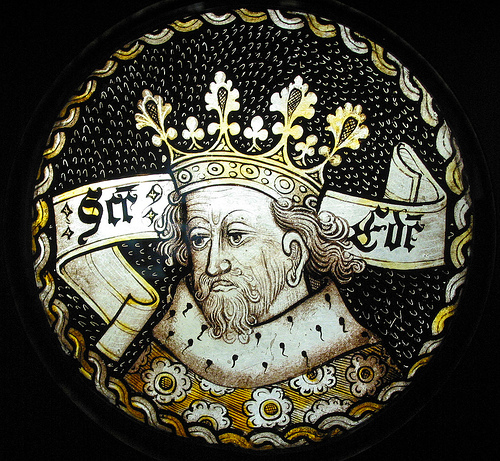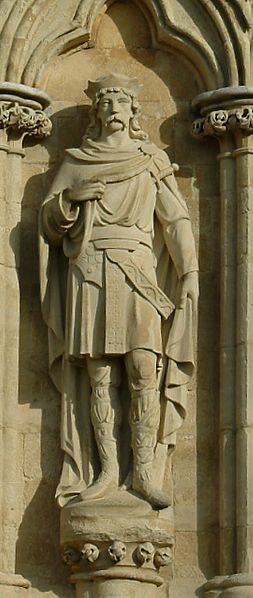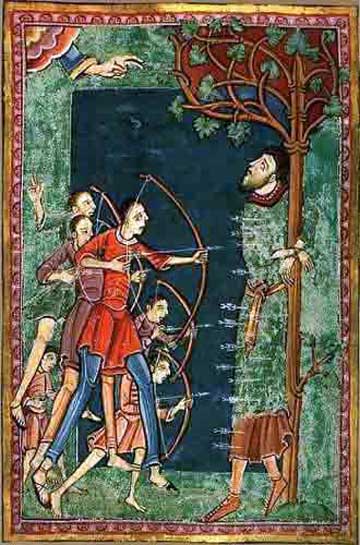The next year (870) is one full of sorrow, and of glory, for Christian England. It witnesses the utter destruction of another Saxon kingdom, adds one worthy English name to the calendar of the saints, several to the roll of our heroes still remembered, and a whole people to the glorious list of those who have died sword in hand and steadfast to the last for faith and fatherland.
In the late summer, one division of the pagan army leaving York take to their ships, and, crossing the Humber, fall on Lindesey (now Lincolnshire), and plunder and burn the monastery of bardeney. The young Algar, alderman of the shire, the friend of Ethelred and Alfred [the Great], springs to arms, and calls out the brave men of the Fens. They flock to his standard, the rich cloisters of the district sending their full quota of fighting men under lay brother Toly, of Croyland Abbey. On the 21st of September, St. Maurice’s Day, the Christian host fell on the [Danish] Pagans at Kesteven, and in that first fight three kings were slain, and Algar pursued the Pagans to the entrance of their camp.
But help for the vanquished was at hand. The other division of the Pagans, in which were now five kings—Gunthrum, Bagsac, Oskytal, Halfdene, and Amund—and the jarls Hinguar and Hubba, Frene, and the two Sidrocs, marching over land through Mercia, arrive on the field. Algar, Toly, and their comrades, now fearfully overmatched, receive the Holy Sacrament in the early morning, and stand there to win or die. Algar commands the center of the Christian battle, Toly and Morcar the right wing, Osgot of Lindesey and Harding of Rehal (we cannot spare the names of one of them) the left. The Pagans, having buried their slain kings, hurl themselves on the Christian host, and through the long day Algar and his men stand together and beat back wave after wave of the sea-kings’ onslaught. At last the Christians, deceived by a feigned retreat, break their solid ranks and pursue. Then comes the end. The Pagans turn, stand, and surrounded and outnumbered, Algar, Toly, and their men die where they had fought, and a handful of youths only escape of all the Christian host to carry the fearful news to the monks of Croyland. The pursuers are on their track. Croyland is burnt and pillaged before the treasures can be carried to the forests.

Memorial to St.Edmund This memorial erected to King Edmund the Martyr on the spot where a oak tree was said to have stood and to which King Edmund was tied and shot with arrows before being beheaded, the oak tree fell in 1843 and on breaking up Viking arrowheads was found embedded in it. Photo by Keith Evans
Four days later Medeshamsted (Peterborough) shares the same fate; soon afterwards Huntingdon and Ely; and in all those fair shires scarcely man, woman, or child remain to haunt like ghosts the homes which had been theirs for generations. The pagan host, leaving the desolate land a wilderness behind them, turn southeast and make their headquarters at Thetford. Edmund, king of the East Anglians, a just and righteous ruler, very dear to his people—no warrior, it would seem, hitherto, but one who can at least do a brave leader’s part—he now arms and fights fiercely with the Pagans, and is slain by them, with the greater part of his followers, near the village of Hoxne. Tradition says that the king was taken alive, and, refusing to play the renegade, was tied to a tree, and shot to death, after undergoing dreadful tortures. His head was struck off, and the corpse left for wolf or eagle, while his murderers fell on town and village, and minster and abbey, throughout all that was left of East Anglia, so that the few people who survived fled to the forests for shelter.
Nevertheless, a monk or two from Croyland, and other faithful men of the eastern counties, managed to steal out of their hiding places and take up the slain body and severed head of their good King Edmund. “They embalmed him with myrrh and sweet spices, with love, pity, and all high and awful [awesome] thoughts, consecrating him with a very storm of melodious , adoring admiration and sun-dyed showers of tears; joyfully, yet with awe (as all deep joy has something of the awful [awesome] in it), commemorating his noble deeds and god-like walk and conversation while on earth. Till at length the very Pope and cardinals at Rome were forced to hear of it; and they summing up as correctly as they well could with ‘Advocatus Diaboli’ pleadings, and their other forms of process, the general verdict of mankind declared: that he had in very fact led a hero’s life in this world, and being now gone, was gone, as they conceived, to God above, and reaping his reward there.” So King Edmund was canonized, and his body entombed in St. Edmund’s shrine, where a splendid abbey in due time rose over it, some poor fragments of which may still be seen in the town of Bury St. Edmunds.
Thomas Hughes, Alfred the Great (New York: MacMillan and Co., 1891), 63-.
Short Stories on Honor, Chivalry, and the World of Nobility—no. 284









